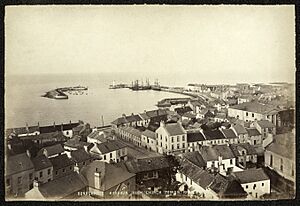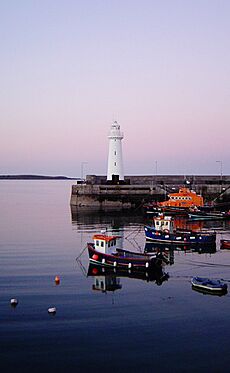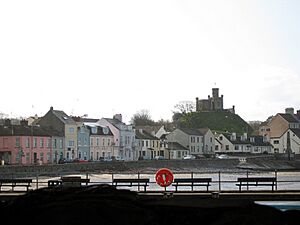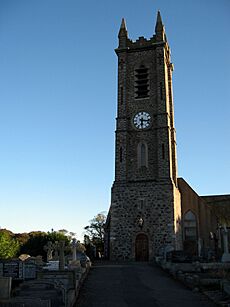Donaghadee facts for kids
Quick facts for kids Donaghadee
|
|
|---|---|
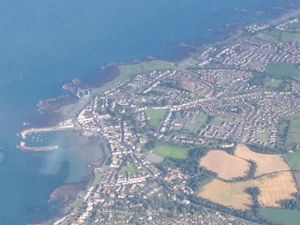 Aerial View of Donaghadee. |
|
| Population | 6,869 (2011 Census) |
| District |
|
| County | |
| Country | Northern Ireland |
| Sovereign state | United Kingdom |
| Post town | DONAGHADEE |
| Postcode district | BT21 |
| Dialling code | 028 |
| Police | Northern Ireland |
| Fire | Northern Ireland |
| Ambulance | Northern Ireland |
| EU Parliament | Northern Ireland |
| UK Parliament |
|
Donaghadee is a small town located in County Down, Northern Ireland. It sits on the northeast coast of the Ards Peninsula. Donaghadee is about 18 miles (29 km) east of Belfast. It is also about 6 miles (10 km) southeast of Bangor. In 2011, about 6,869 people lived there.
Contents
History of Donaghadee
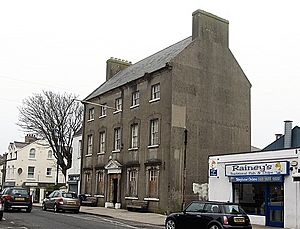
The name 'Donaghadee' comes from an old Irish name, Domhnach Daoi. This name might mean "church of Daoi" (a saint) or "church of the motte". A motte is a type of hill.
Long ago, there was a Gaelic ringfort here. This was a circular fort made of earth. Later, in the late 1100s, the Anglo-Normans built a motte-and-bailey castle on the site. This was a simple castle with a tower on a mound (motte) and a walled courtyard (bailey).
In the early 1600s, a man named Hugh Montgomery brought Scottish Protestants to live here. This was part of the Plantation of Ulster, a plan to settle people from Scotland and England in Ireland. Donaghadee then started to grow into a small town. The old Donaghadee Town Hall was once a merchant's house. It was finished around 1770.
The town played a part in the Irish Rebellion of 1798. On June 10, 1798, a group of United Irishmen tried to take over the town of Newtownards. They were defeated by musket fire.
From 1759 to 1826, Donaghadee was a popular place for couples to get married. They would travel by boat to Portpatrick in Scotland. Portpatrick was known as the "Gretna Green for Ireland" because it was easy to marry there.
The lifeboat station at Donaghadee harbour opened in 1910. It is very important for rescues along the Irish coast. A famous lifeboat, the Sir Samuel Kelly, was based here. It is now on display at the harbour. On January 31, 1953, this lifeboat helped rescue many people. They were survivors from the ferry, MV Princess Victoria, which sank in the Irish Sea.
Donaghadee also had a railway station. It carried passengers from 1861 until 1950. It was part of the Belfast and County Down Railway.
Places to Visit in Donaghadee
Harbour and Lighthouse
Donaghadee is well-known for its harbour and lighthouse. The plans for the harbour were first made by John Rennie Senior. His son, Sir John Rennie, finished the work in 1825. The lighthouse was built from limestone and completed in the late 1830s.
During the COVID-19 quarantine, many people, especially younger ones, placed painted stones near the harbour. These stones showed support for the National Health Service (NHS) or had fun drawings. They were removed later, but in 2022, a bench on the motte was painted with similar designs.
The Motte
The Motte, or Moat, in Donaghadee was originally a motte-and-bailey castle. The Anglo-Normans built it in the late 1100s. The small castle-like building on top of the motte was built in the early 1800s. It was used to store gunpowder when the new harbour was being built. Today, it is part of a park. From here, you can see great views of the town and the Copeland Islands.
Other Activities
You can enjoy scenic walks along the marine walk at The Commons. This is a 16-acre (6.5 ha) open space. It has areas for bowls, tennis, and exercise equipment. There is also a putting green and an adventure playground.
Donaghadee has several restaurants and pubs. One famous pub is Grace Neill's. It opened in 1611 as the "King's Arms." It claims to be the oldest bar in Ireland.
Wildlife in Donaghadee
Birds
The Copeland Bird Observatory is on Lighthouse Island. This is one of three islands you can see from Donaghadee. The observatory collects information on migrating birds. They put rings on birds to track where they travel. The islands are very important for breeding Manx Shearwater and Arctic Tern birds.
Plants
Many types of algae (seaweed) have been found in Donaghadee. These include Gastroclonium ovatum and Callophyllis laciniata. Different flowering plants have also been recorded in the area.
Donaghadee Male Choir
The Donaghadee Male Choir started in 1932. It began as a small group singing in churches and local events. Now, the choir has over 70 members. They have performed in many countries around the world.
Donaghadee in the Media
Donaghadee was the inspiration for the town of Donaghadoo in the children's TV show Lifeboat Luke. This show was animated by a studio in Donaghadee called Straandlooper. The town was also used as a filming location for parts of the movie Mickybo and Me.
Donaghadee can be seen in other films too. These include Robot Overlords starring Gillian Anderson, Divorcing Jack, and Killing Bono. It also appeared in Mo, a film about Mo Mowlam, starring Julie Walters.
Donaghadee is the fictional town of Port Devine in the BBC drama Hope Street. This show first aired in 2021. The town is also mentioned in the song Forty Shades of Green, written by Johnny Cash in 1959.
Sports in Donaghadee
Donaghadee Rugby Football Club played its first game in 1885. Donaghadee Football Club is a football team. They play their home games at Crommelin Park. Donaghadee Ladies' Hockey Club has two teams that play in Ulster Hockey leagues. Donaghadee Sailing Club opened a new clubhouse in 2009.
Famous People from Donaghadee
- Bear Grylls, a famous adventurer and TV presenter, lived in Donaghadee until he was four years old.
- Sir Walter Smiles and his daughter Patricia, Lady Fisher lived in the town. They were both Members of Parliament (MPs).
- Sarah Grand, an author and feminist.
- Sylvia, Lady Hermon, a former MP for North Down.
- John MaGowan, a former professional darts player.
See also
 In Spanish: Donaghadee para niños
In Spanish: Donaghadee para niños



